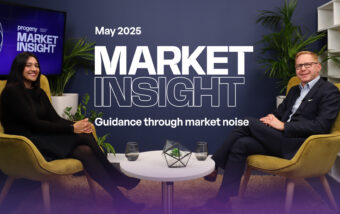The second quarter of 2025 has been marked by significant political, economic, and financial turbulence. From rising tariffs and ballooning debt issuance to mounting geopolitical risks and shifts in global economic power, investors are navigating a landscape that feels increasingly unstable.
Although a full-blown recession has been avoided, economic risks remain high. The U.S. economy faces headwinds from policy uncertainty and a sharp uptick in tariffs, while Europe and Asia present their own challenges. Despite these pressures, markets have shown resilience amid continued volatility.
The recent Iran-Israel conflict triggered a brief spike in geopolitical tensions, though market impacts were contained. Increased OPEC production exerted downward pressure on oil, and despite a short-lived price rally (Brent crude hit $80 intra-day on June 22nd), prices closed the quarter at $68 per barrel. While precious metals performed well, broad commodities underperformed other risk assets.
Global Economic Outlook
Global economic momentum has moderated. Major institutions – the IMF, OECD, and World Bank – have lowered their 2025 growth forecasts to the 2.0–2.3% range, below historical averages.
Inflation trends remain mixed. In the U.S., consumer prices have yet to fully reflect tariff increases, though producer prices and inflation expectations are edging higher. Globally, inflation is being tugged between tariff-induced cost increases and disinflationary forces stemming from slower growth and weaker commodity prices. Central banks must now balance these opposing pressures.
Growth Assets
Q2 was a reminder of the enduring dominance of the U.S. tech giants, particularly the “Magnificent 7,” who rebounded strongly after a volatile start to the year. Despite early fears of a bear market, the S&P 500 hit a new all-time high by quarter-end, illustrating the strength of large-cap U.S. equities even amid political noise.
European and UK equities outperformed the U.S. year-to-date, though Q2 returns lagged other developed markets. Stronger-than-expected earnings in sectors like industrials and financials, coupled with ongoing fiscal support, have helped sustain performance. Valuations remain attractive, and investor capital is rotating toward non-U.S. markets.
Asia and emerging markets benefited from policy easing and shifting trade patterns. Still, geopolitical tensions and reliance on Chinese demand pose ongoing risks. These regions continue to offer valuable diversification, but with caution warranted.
Overall, equities remain supported by buybacks and modest earnings growth, although policy uncertainty and macroeconomic headwinds are limiting upside potential.
Factor and Style Performance
Investor sentiment rebounded in Q2, driving strong gains in growth stocks. The “Magnificent 7” delivered returns of 18.6%, helping growth as a factor post a 17.7% quarterly return – making it the best-performing asset class.
Value stocks lagged significantly, while small-cap equities drew interest through buyback activity and takeover speculation. This rotation underscores continued investor focus on quality and size during uncertain times.
Defensive Assets
Fixed income and currency markets were rattled by the introduction of tariffs on “Liberation Day,” which reverberated beyond equities to affect bond yields and FX rates. Investor confidence in the U.S. as a traditional safe haven has been shaken, largely due to erratic policy moves under the Trump administration.
Yields on U.S. 10-year Treasuries fluctuated between 4.0% and 4.8%, with 30-year yields rising above 5%-a reflection of growing concern over debt levels and reduced international appetite for U.S. debt.
Central banks are in a holding pattern. The Federal Reserve is expected to make modest rate cuts later in the year, depending on how inflation and employment data evolve.
The European Central Bank and Bank of England have already started easing or indicated they will soon. Meanwhile, China continues targeted stimulus efforts to bolster growth. The direction of future policy will largely hinge on the persistence of inflation and unfolding geopolitical developments.
Outlook
The first half of 2025 has been anything but smooth, and the remainder of the year is unlikely to bring greater clarity. The Trump tariffs, in particular, remain a wildcard with potential to drive further market volatility as the 90-day pause period ends. Inflation and interest rate updates from central banks will be key events to watch.
Amid this uncertainty, the quarter offered a clear reminder of the benefits of diversification. As market leadership broadens beyond U.S. mega caps, opportunities are appearing across regions, styles, and sectors. Investors would do well to keep a long-term perspective and brace for more twists ahead.
For our full glossary of terms please click here.
This article contains the opinions of the author but not necessarily the Firm and does not represent a recommendation of any particular security, strategy or investment product. This article is distributed for educational purposes only and should not be considered financial advice.
Information contained herein has been obtained from sources believed to be reliable but is not guaranteed.
The information in this article aims to provide information. However, this is not intended to form professional advice nor should it be relied upon as such and before taking any particular action, specific and personal advice should be obtained. All levels and basis of, and relief from taxation illustrated here are subject to change. Before making any decision, we recommend you consult your financial planner to consider your particular investment objectives, financial situation and individual needs.
This article is distributed for educational purposes and should not be considered investment advice or an offer of any security for sale.
This article contains the opinions of the author but not necessarily the Firm and does not represent a recommendation of any particular security, strategy or investment product.
If you are unsure about the suitability of otherwise of any product or service, we recommend that you seek professional advice.
Past performance is no guarantee of future performance.
The value of an investment and the income from it can fall as well as rise and investors may get back less than they invested. Your capital is therefore always at risk. It should be noted that stock market investing is intended for the longer term.






